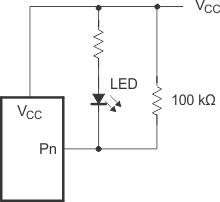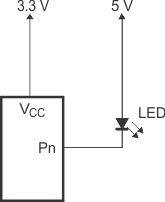SCPS200E July 2009 – April 2019 TCA9555
PRODUCTION DATA.
- 1 Features
- 2 Applications
- 3 Description
- 4 Revision History
- 5 Description (continued)
- 6 Pin Configuration and Functions
- 7 Specifications
- 8 Parameter Measurement Information
- 9 Detailed Description
- 10Application and Implementation
- 11Power Supply Recommendations
- 12Layout
- 13Device and Documentation Support
- 14Mechanical, Packaging, and Orderable Information
Package Options
Mechanical Data (Package|Pins)
Thermal pad, mechanical data (Package|Pins)
Orderable Information
10.2.2.2 Minimizing ICC When I/O Is Used to Control LED
When an I/O is used to control an LED, normally it is connected to VCC through a resistor as shown in Figure 34. Because the LED acts as a diode, when the LED is off, the I/O VIN is about 1.2 V less than VCC. The ΔICC parameter in the Electrical Characteristics table shows how ICC increases as VIN becomes lower than VCC. For battery-powered applications, it is essential that the voltage of I/O pins is greater than or equal to VCC when the LED is off to minimize current consumption.
Figure 35 shows a high-value resistor in parallel with the LED. Figure 36 shows VCC less than the LED supply voltage by at least 1.2 V. Both of these methods maintain the I/O VIN at or above VCC and prevent additional supply current consumption when the LED is off.
 Figure 35. High-Value Resistor in Parallel With LED
Figure 35. High-Value Resistor in Parallel With LED  Figure 36. Device Supplied by Lower Voltage
Figure 36. Device Supplied by Lower Voltage